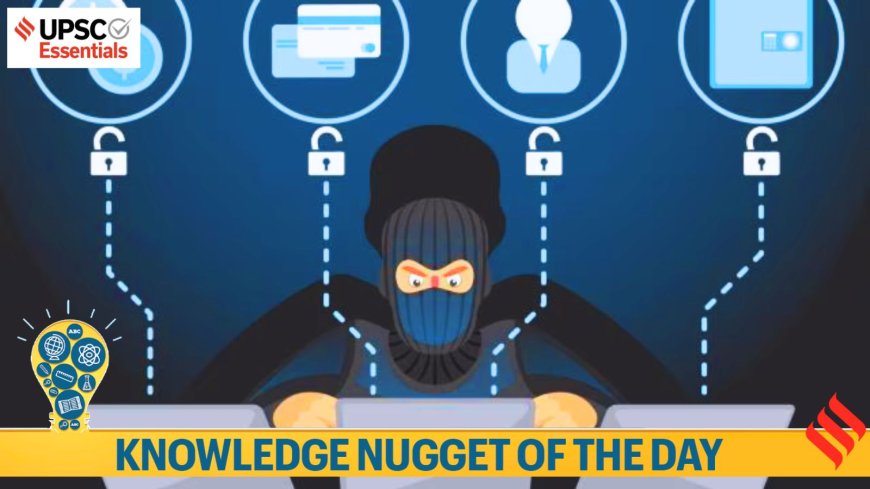Knowledge Nugget | ‘.bank.in’ domain for banks : What all you need to know for UPSC Exam

Asarkari - Sarkari News, Jobs & Updates
Knowledge Nugget | ‘.bank.in’ domain for banks : What all you need to know for UPSC Exam
By Priya Sharma
In today's rapidly digitizing world, the security of online financial transactions is paramount. As cyber threats become increasingly sophisticated, regulatory bodies and institutions are constantly seeking ways to bolster security measures. For UPSC aspirants, understanding these developments, especially in the banking sector, is crucial as they intersect with topics like cybersecurity, governance, economic policy, and digital infrastructure. One significant step in this direction within India is the introduction and promotion of the ‘.bank.in’ domain exclusively for banks. Let's delve into what this domain entails and why it's relevant for your exam preparation.
What is the ‘.bank.in’ Domain?
The ‘.bank.in’ domain is a country-code second-level domain (ccSLD) specifically designated for use by banking institutions operating in India. Unlike generic domains like '.com' or even the country-specific '.in', which are open to registration by almost anyone, ‘.bank.in’ is a restricted and highly secured domain space. Its primary purpose is to provide a trusted and easily identifiable online marker for legitimate banking websites, thereby enhancing security and reducing the risk of phishing and other cyber frauds.
Think of it as a digital hallmark of authenticity for Indian banks. When you see a website address ending in ‘.bank.in’, it signifies that the entity operating it has undergone stringent verification processes mandated by the relevant authorities.
Why Was It Introduced? The Push for Enhanced Security
The financial sector is a prime target for cybercriminals. Phishing attacks, where fraudulent websites mimic legitimate bank portals to steal login credentials and financial information, are rampant. Customers often struggle to differentiate between genuine and fake banking websites, especially when domain names look deceptively similar (e.g., using slight misspellings or different generic top-level domains).
The Reserve Bank of India (RBI) and the Indian Banks' Association (IBA) have been advocating for stronger security measures. The introduction of the ‘.bank.in’ domain, managed under the umbrella of the National Internet Exchange of India (NIXI) through its INRegistry, aims to address these concerns directly. By creating an exclusive digital space, it:
- Increases customer trust and confidence in online banking.
- Makes it significantly harder for fraudsters to create convincing fake bank websites.
- Provides a clear visual cue for users to verify the legitimacy of a banking site.
- Aligns with global best practices for secure domain extensions in critical sectors.
Who Manages ‘.bank.in’ and What are the Eligibility Criteria?
The INRegistry, operating under NIXI (an autonomous body under the Ministry of Electronics and Information Technology, MeitY), is the custodian of the .IN domain, including its sub-domains like ‘.bank.in’. However, the verification and eligibility processes involve coordination with financial regulators like the RBI.
To be eligible to register a ‘.bank.in’ domain, an entity must typically be:
- A bank licensed by the Reserve Bank of India.
- A cooperative bank regulated under relevant state or central acts.
- Other financial institutions specifically approved by the RBI or the government for this purpose.
This strict vetting process ensures that only legitimate banking players can secure a domain under this extension, preventing misuse.
Security Features and Benefits
The ‘.bank.in’ domain comes with enhanced security requirements compared to standard domains. While specifics might evolve, the framework generally mandates stricter operational security, domain name system security extensions (DNSSEC) implementation, and robust verification protocols. DNSSEC, for example, helps prevent DNS spoofing or cache poisoning, ensuring users are directed to the authentic server associated with the domain name.
The key benefits include:
- Reduced Phishing Risk: Harder for criminals to impersonate banks online.
- Enhanced User Trust: Customers can more easily identify genuine banking sites.
- Stronger Security Posture: Mandated security protocols raise the bar for bank website security.
- Clear Identification: Unambiguous identifier for legitimate Indian banking entities.
For more updates on government initiatives and digital security, you might want to visit other sections on our portal. For instance, staying updated on cybersecurity guidelines is crucial. For more updates, visit https://asarkari.com.
Relevance for UPSC Aspirants
Understanding the ‘.bank.in’ initiative is relevant for the UPSC Civil Services Examination in several ways:
- Prelims: Questions could touch upon cybersecurity measures in banking, the role of NIXI/INRegistry, types of domain names (gTLD, ccTLD, ccSLD), or recent RBI initiatives related to digital banking security. Example: "Which body manages the '.in' domain registry in India?" or "The '.bank.in' domain aims primarily to address which issue?"
- GS Paper 3 (Economy & Science and Technology - Cybersecurity): This topic fits perfectly under 'Challenges to internal security through communication networks, role of media and social networking sites in internal security challenges, basics of cyber security; money-laundering and its prevention' and 'Indian Economy and issues relating to planning, mobilization, of resources, growth, development and employment.' It showcases government/RBI efforts to secure critical digital infrastructure and combat financial fraud. You can use it as an example in answers related to banking reforms, digital India challenges, or cybersecurity frameworks.
- GS Paper 2 (Governance): It highlights aspects of e-governance, regulatory mechanisms, and the role of autonomous bodies like NIXI in managing national digital resources.
- Essay: Could be relevant for essays touching upon technology's role in society, security challenges in the digital age, or financial inclusion and security.
Knowing the 'why' behind such initiatives (combating cyber fraud, enhancing trust) and the 'who' (RBI, NIXI, IBA) provides valuable points for analysis and answer writing.
Conclusion
The ‘.bank.in’ domain is more than just a new website address format; it represents a significant step towards fortifying India's digital banking ecosystem. By creating a verified, secure, and exclusive online space for banks, it aims to protect consumers and enhance trust in digital financial services. For UPSC aspirants, it serves as a concrete example of policy in action, addressing contemporary challenges at the intersection of technology, economy, and governance. Keeping abreast of such "Knowledge Nuggets" is vital for a comprehensive understanding of India's evolving landscape.
kam sabdo me kahein to, the ‘.bank.in’ domain is a highly secure, exclusive internet domain for verified Indian banks, managed by INRegistry under NIXI and supported by RBI, aimed at preventing online fraud and enhancing customer trust in digital banking.
Team Asarkari
Keywords
.bank.in domain, Indian banks domain, secure banking domain, RBI domain initiative, NIXI India, INRegistry, UPSC banking syllabus, cybersecurity in banking, digital banking India, gTLD India, ccSLD India, phishing prevention banking, financial cybersecurity India, UPSC economy current affairs, UPSC science and technology cybersecurityWhat's Your Reaction?
 Like
0
Like
0
 Dislike
0
Dislike
0
 Love
0
Love
0
 Funny
0
Funny
0
 Angry
0
Angry
0
 Sad
0
Sad
0
 Wow
0
Wow
0









































